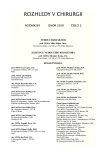Axilloscopy – An Option in Axillary Lymph Nodes Dissections in Breast Carcinomas
Authors:
M. Kašpar; T. Paseka; J. Vokurka; L. Veverková; V. Chrenko
Authors‘ workplace:
Chirurgické oddělení nemocnice Boskovice
; I. chirurgická klinika FN u sv. Anny Brno
Published in:
Rozhl. Chir., 2010, roč. 89, č. 2, s. 118-123.
Category:
Monothematic special - Original
Overview
Authors in this randomised prospective study, which occurred in years 2007 to 2008 on the St. Anne’s First Surgical Clinic in 56 breast cancer female patients, compare the results of minimally invasive axillary dissection to those of the classical axillary dissection and point to the advantages and setbacks of this new method both for the patient and surgeon.
Key words:
breast carcinoma – axillary dissections – lymph nodes
Sources
1. Danforth, D. N. The role of axillary lymph node dissection in the management of breast cancer.
2. Clark, G. M. Prognostic and predictive factors. In: Harris, J. R., Lippman, M. R., Morrow, M., et al (eds): Diseases of the Breast, New York, Lippincott-Raven, 1996er. PPO Updates 6 : 2, 1992, pp 461–485..
3. Chadha, M., Ghossein, N. Treatment of the axilla with radiation therapy without an axillary dissection in patients with invasive breast cancer. Int. J. Radiat. Oncol. Biol. Phys. (suppl), 1997, in press.
4. Lin, P. P., Allison, D. C., Wainstock, J., et al. Impact of axillary lymph node dissection on the therapy of breast cancer patients. J. Clin. Oncol., 1993, 11 : 1536–1544.
5. Amalric, R., Santamaria, F., Robert, F., et al. Conservation therapy of operable breast cancer – results at five, ten and fifteen years in 2216 consecutive cases. In: Harris, J. R., Hellman, S., Slen, W. (eds): Conservative Management of Breast Cancer, New York, JB Lippincott, 1983, pp 15–21.
6. Calle, R., Pilleron, J. P., Schlienger, P., et al. Conservative management of operable breast Cancer: Ten years experience at the Foundation Curie. Cancer, 1978, 42 : 2045–2053.
7. Fisher, B. The revolution in breast cancer surgery: Science or anecdotalism? World J. Surg., 9, 1985, s. 655–666.
8. Fisher, B. Conservative surgery: The American experience. Semin. Oncol., 13, 1986, s. 425–433.
9. Fisher, B., Anderson, S., Redmond, C., Wickerham, D. L., Wolmark, N., Wickerham, D. L., Cronin, W. M. Reanalysis and results after 12 years of follow-up in a randomized clinical trial comparing total mastectomy with lumpectomy with or without irradiation in the treatment of breast cancer. Engl. J. Med., 333, 1995, s. 1456–1461.
10. Fisher, B. On clinical trial participation [editorial]. J. Clin. Oncol., 1991, 9 : 1927–1930.
11. Veronesi, U., Saccozzi, R., Del Vecchio, M., Banfi, A., Clemente, C., De Lena, M., Gallus, G., Greco, M., Luini, A., Marubini, E., Muscolino, G., Rilke, F., Salvadori, B., Zecchini, A., Zucali, T. Comparing radical mastectomy with quadrantectomy, axillary dissection, and radiotherapy in patients with small cancers of the breast. N. Engl. J. Med., 305, 1981, s. 6–11.
12. Veronesi, U., Salvadori, B., Luini, A., Greco, M., Saccozzi, R., Del Vecchio, M., Mariani, L., Zurrida, S., Rilke, F. Breast conservation is a safe method in patients with small cancer of the breast. Long-term results of three randomized trials on 1973 patients. Eur. J. Cancer, 31A, 1995, s. 1574–1579.
13. Wazer, D. E., Erban, J. K., Robert, N. J., et al. Breast conservation in elderly women for clinically negative axillary lymph nodes without axillary dissection. Cancer, 74 : 878–883, 1994.
14. Montague, E. D., Schell, S. R., Romsdahl, M. M., et al. Conservation surgery and irradiation in clinically favorable breast cancer – The M. D. Anderson experience. In: Harris, J. R., Hellman, S., Silen, W.(eds): Conservative Management of Breast Cancer. New York, JB Lippincott, 1983, pp. 53–59.
15. Arnesson, L.-G., Dufmats, M. Results of axillary dissection in small breast cancers (1-15 mm) leading to a trial where axillary surgery is omitted (abstract). Breast Cancer Res. Treat., 41 : 273, 1997.
16. Pavlišta, D., Dušková, M., Novotný, J., Zikán, M., Strunová, M., Freitag, P., Živný, J. Komplikace disekce axily pro karcinom prsu. Čes. Gynek., 67, 2002, č. 6, s. 333–337.
17. Goss, P. E., Hack, T., Cohen, L., et al. Long term physical and psychological morbidity of axillary lymph node dissection in patients with breast cancer. Breast Cancer Res. Treat., 41 : 274, 1997.
18. Kissin, M. W., Querci della Roveret, G., Easton, D., et al. Risk of lympho-edema following the treatment of breast cancer. Br. J. Surg., 1986, 73 : 580–584.
19. Pezner, R. D., Patterson, M. P., Hill, L. R., et al. Arm lymphedema in patients treated conservatively for breast cancer: Relationship of patient age and axillary node dissection technique. Int. J. Radiat. Oncol. Biol. Phys., 12 : 2079, 1986.
20. Hussein, O., El-Nahhas, W., El-Saed, A., Denewer, A. LinksVideo-assisted axillary surgery for cancer: non-randomized comparison with conventional techniques. Breast, 2007 Oct; 16(5): 513–519. Epub 2007 May 25.
21. Kühn, T., Santjohanser, C., Koretz, K., Böhm, W., Kreienberg, R. LinksAxilloscopy and endoscopic sentinel node detection in breast cancer patients. Surg. Endosc., 2000 Jun; 14(6): 573–577.
22. Harder, F., Zuber, M., Kocher, T., Torhorst, J. Recent Results Cancer Res. LinksEndoscopic surgery to the axilla – a substitute for conventional axillary clearance? 1998; 152 : 180–189.
23. Salvat, J., Knopf, J. F., Ayoubi, J. M., Slamani, L., Vincent-Genod, A., Gilbert, M., Walker, D. Links Endoscopic exploration and lymph node sampling of the axilla. Preliminary findings of a randomized pilot study comparing clinical and anatomo-pathologic results of endoscopic axillary lymph node sampling with traditional surgical treatment. Eur. J. Obstet. Gynecol. Reprod. Biol., 1996, Dec 27; 70(2): 165–173
Labels
Surgery Orthopaedics Trauma surgeryArticle was published in
Perspectives in Surgery

2010 Issue 2
Most read in this issue
- Osteoplastic Decompressive Craniotomy – Indication and Surgical Technique
- Complications in Patients Undergoing Pulmonary Oncological Surgery
- PCCP – First Choice of the Treatment of Trochanteric Fractures in our Orthopaedic Department
- Type II Bile Duct Cyst or Accessory Gall Bladder?
